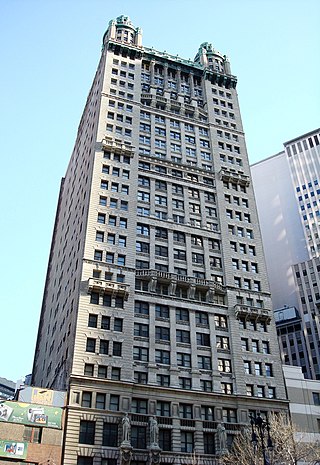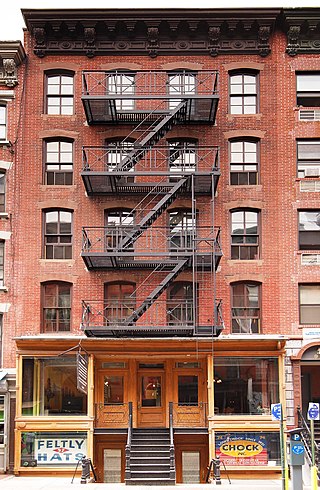
An apartment, flat, or unit, is a self-contained housing unit that occupies part of a building, generally on a single storey. There are many names for these overall buildings, see below. The housing tenure of apartments also varies considerably, from large-scale public housing, to owner occupancy within what is legally a condominium, to tenants renting from a private landlord.

A tenement is a type of building shared by multiple dwellings, typically with flats or apartments on each floor and with shared entrance stairway access. They are common on the British Isles, particularly in Scotland. In the medieval Old Town, in Edinburgh, tenements were developed with each apartment treated as a separate house, built on top of each other. Over hundreds of years, custom grew to become law concerning maintenance and repairs, as first formally discussed in Stair's 1681 writings on Scots property law. In Scotland, these are now governed by the Tenements Act, which replaced the old Law of the Tenement and created a new system of common ownership and procedures concerning repairs and maintenance of tenements. Tenements with one or two room flats provided popular rented accommodation for workers, but in some inner-city areas, overcrowding and maintenance problems led to shanty towns, which have been cleared and redeveloped. In more affluent areas, tenement flats form spacious privately owned houses, some with up to six bedrooms, which continue to be desirable properties.

The Park Row Building, also known as 15 Park Row, is a luxury apartment building and early skyscraper on Park Row in the Financial District of the New York City borough of Manhattan. The 391-foot-tall (119 m), 31-story building was designed by R. H. Robertson, a pioneer in steel skyscraper design, and engineered by the firm of Nathaniel Roberts. The Park Row Building includes 26 full floors, a partial 27th floor, and a pair of four-story cupolas. The architectural detail on the facade includes large columns and pilasters, as well as numerous ornamental overhanging balconies. J. Massey Rhind sculpted several ornamental details on the building, including the balconies and several figures atop the building.
One of the reforms of the Progressive Era, the New York State Tenement House Act of 1901 was one of the first such laws to ban the construction of dark, poorly ventilated tenement buildings in the state of New York. Among other sanctions, the law required that new buildings must be built with outward-facing windows in every room, an open courtyard, proper ventilation systems, indoor toilets, and fire safeguards.

The Lower East Side Tenement Museum, located at 97 and 103 Orchard Street in the Lower East Side neighborhood of Manhattan, New York City, is a National Historic Site. The museum's two historical tenement buildings were home to an estimated 15,000 people, from over 20 nations, between 1863 and 2011. The museum, which includes a visitors' center, promotes tolerance and historical perspective on the immigrant experience.

21 West Street, also known as Le Rivage Apartments, is a 33-story building located in the Financial District of Lower Manhattan in New York City, on Morris Street between West Street and Washington Street. It was built in 1929–1931 as a speculative office tower development in anticipation of an increased demand for office space in Lower Manhattan. The building was converted into apartments in 1997 and was renamed Le Rivage.

Old Law Tenements are tenements built in New York City after the Tenement House Act of 1879 and before the New York State Tenement House Act of 1901. The 1879 law required that every habitable room have a window opening to plain air, a requirement that was met by including air shafts between adjacent buildings. Old Law Tenements are commonly called "dumbbell tenements" after the shape of the building footprint: the air shaft gives each tenement the narrow-waisted shape of a dumbbell, wide facing the street and backyard, narrowed in between to create the air corridor. They were built in great numbers to accommodate waves of immigrating Europeans. The side streets of Manhattan's Lower East Side are still lined with numerous dumbbell structures today.

The Broadway–Chambers Building is an 18-story office building at 277 Broadway, on the northwest corner with Chambers Street, in the Civic Center and Tribeca neighborhoods of Manhattan in New York City. Completed by 1900 to designs by architect Cass Gilbert, the Broadway–Chambers Building was the first of several that Gilbert designed in the city.

The former Eighth Precinct Police Station is a building located at 4150 Grand River Avenue in the Woodbridge Historic District of Detroit, Michigan, United States. It is the second-oldest police building in Detroit, and was designated a Michigan State Historic Site in 1973 and listed on the National Register of Historic Places in 1974. The building now houses the Detroit Castle Lofts.

109 Washington Street is a five-story tenement in the Financial District of Manhattan in New York City, within the area once known as Little Syria. Due to demolitions connected to the construction of the Brooklyn–Battery Tunnel and the World Trade Center, it stands as the last tenement on a portion of lower Washington Street that has been estimated by Kate Reggev to have contained around 50 tenements. After September 11, 2001, its proximity to the World Trade Center site made it the subject of some media attention, including a nationally syndicated radio story about the experiences of its residents on the day of the attack. In recent years, community officials, activists, and preservationists have advocated for its designation as a landmark as part of a mini-historical district with the connected buildings of St. George's Syrian Catholic Church and the Downtown Community House.
Lawrence Turner Veiller (1872–1959) was an American social reformer of the Progressive Era in New York. He was a major figure in the Good government and urban planning movements of the early twentieth century.

The Martinique New York on Broadway, Curio Collection by Hilton is a 532-room hotel at 53 West 32nd Street in Manhattan, New York City. It was designed by Henry Janeway Hardenbergh and built by William R. H. Martin, who headed the Rogers Peet business, in a French Renaissance style. The Martinique was developed in three sections between 1897 and 1911. The hotel is a New York City designated landmark and is part of the Historic Hotels of America.

August Cieszkowski Street belongs to architecturally remarkable streets of Bydgoszcz, with its Art Nouveau features from the Fin de siècle period, forming a homogeneous complex of tenements from the end of 19th-century beginnining of 20th century, most of which are registered on Kuyavian-Pomeranian Voivodeship Heritage List.

Pomorska Street is an important street in downtown Bydgoszcz.

Kołłątaja street is a historical street of downtown Bydgoszcz.

The Morse Building, also known as the Nassau–Beekman Building and 140 Nassau Street, is a residential building in the Financial District of Manhattan in New York City, at the northeast corner of Nassau and Beekman Streets. The Morse Building, designed by Benjamin Silliman Jr. and James M. Farnsworth, contains elements of the Victorian Gothic, Neo-Grec, and Rundbogenstil style.

Królowej Jadwigi Street is a street located in Bydgoszcz, Poland. Many of its buildings are either registered on Kuyavian-Pomeranian Voivodeship heritage list, or part of Bydgoszcz local history.

Staszica and Paderewskiego streets are located in downtown district, in Bydgoszcz, Poland. Many of the buildings along this axis are either registered on the Kuyavian-Pomeranian Voivodeship heritage list, or part of a historical ensemble of Eclectic and Art Nouveau architecture in Bydgoszcz.

The Madison Belmont Building, also known as 183 Madison Avenue, is a commercial building at the southeast corner of Madison Avenue and 34th Street in Murray Hill, Manhattan, New York. It was designed by Warren & Wetmore in the Neoclassical style and built in 1924–1925. The Madison Belmont Building has a "transitional" design that deviates from Warren & Wetmore's other commissions, combining elements of the Neoclassical style and more modern influences from the Art Deco style.


















